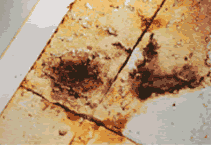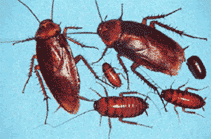Indoor Air Quality
People with asthma have airways that are very twitchy or sensitive. These airways may react to things that can (or cause) asthma symptoms. When a person with asthma breathes in an asthma trigger, their airways may swell up, tighten up, and produce too much mucus. The person may then start to wheeze or cough, and may develop congestion, itchy eyes, or a runny nose. Because of this, it is important for people with asthma to
find out what their asthma triggers are and learn ways to control
them.
Many different things in the indoor environment can be asthma triggers
and can affect people with asthma. It has been recognized that because Americans spend so much
time indoors – over 90% of the day is spent at home, school,
and/or work – it is important that people with asthma maintain
healthy indoor environments that reduce these exposures to indoor
triggers of asthma.
Weather-related and man-made emergencies and disasters can damage homes and buildings and make the air indoors unhealthy to breathe. With climate change, weather-related emergencies are becoming more frequent and more severe. EPA's updated Emergencies and IAQ webpage provides tips on how to prepare for, respond to, and recover from weather-related and man-made emergencies and disasters that affect indoor environments, including: wildfires, power outages, flooding, snow and ice, and chemical, biological and radiological and nuclear threats.
Not only can poor indoor air quality make the symptoms of someone who
already has asthma worse, but it may also play a role in the
development of asthma in more susceptible people, like small
children. In addition, some people with asthma may be more sensitive to certain
indoor air triggers than other people with asthma are.
To help you find out what these asthma triggers are, people
with asthma often keep a written record of their activities. Writing down what they were doing, and where, whenever
there are symptoms will help to find out if being near certain
things causes the asthma symptoms. For example, if asthma symptoms are worse when making the bed
or vacuuming, dust mites may be a trigger.
Indoor air triggers can be classified as either irritants or allergens. Irritants include gases such as volatile organic
compounds (VOC) that can aggravate the airways and cause
inflammation. Irritants
also include small particles that can reach the lower regions of
the respiratory tract and cause inflammation. Examples of irritants include the following:
- Tobacco smoke, a well-documented respiratory tract irritant, can induce wheezing or
an asthma attack in people with asthma. Smoke particles remain in the air long after the cigarette has been put out.
- Nitrogen dioxide (NO2) is a gas given off by indoor combustion
appliances such as gas stoves and gas or kerosene space heaters. The presence of NO2 indoors may increase the
risk of respiratory infections that can make asthma worse.
- Household dust includes a range of particles from smoke to pet dander. Smaller particles remain airborne for longer periods, and
therefore are more readily inhaled than larger particles that
settle out more quickly onto floors, beds, countertops, and other
surfaces. However, if particles are not routinely cleaned from heavy traffic areas or
locations where air disturbances or currents occur, settled particles could become airborne again.
- Chemical odors are given off from a wide variety of materials: paint, solvents,
pesticides, adhesives, particleboard, vinyl flooring and tiles,
dry-cleaned clothes, toner from photocopiers, and cleaning agents
used in the home. These odors can an asthma attack in people with asthma.
- People with asthma may be quite sensitive to certain
fragrances such as perfumes, scented detergents and soaps, personal
deodorants, and room deodorizers.
- There are known causes of
work-related asthma.
Allergens are materials that cause an immune-type reaction in people who are
sensitized to these materials. Allergens found in indoor air are primarily biological
material such as pet dander, cockroach and other insect pest
particles, pollen, bacteria, and mold. All of these materials are small particles, can become
airborne, and thus, are easily inhaled. Allergens that are inhaled by sensitized people with asthma
can cause asthma attacks. For
example, if you think about a group of people with asthma, the
presence of cat allergen could bring on an asthma attack in people
with cat allergies, but not in those people who do not have cat
allergies.
Following is more information on the most well recognized indoor
air allergens and irritants that have been linked to asthma.  The list also includes information on where you can learn
more about each topic.
The list also includes information on where you can learn
more about each topic.
Tobacco Smoke
Environmental tobacco smoke (
ETS) or secondhand smoke is an irritant to the
eyes, nose, and throat, and can cause permanent damage to the
lungs. It may cause asthma attacks and respiratory infections to happen more often,
and may cause the development of asthma in children. Infants and children are most vulnerable to ETS because their lungs are still developing.
Learn more about secondhand smoke and asthma.
 Mold
Mold
Molds are fungi that appear as cottony tufts. Molds reproduce by making and releasing spores, which range
in size from 2 to 100 micrometers. Spores become airborne when released by the mold or when
disturbed through physical contact. Certain molds may also contain substances called mycotoxins
that act as irritants in both allergic and non-allergic people. Spores, mycotoxins, and other components can trigger respiratory irritation. High
humidity and dampness in the home permit the growth of these
microorganisms in heating, ventilating and air conditioning
systems (HVAC), dehumidifiers, condensate pans, damp insulation,
plaster/sheetrock, and carpets.
 Cockroaches and Other Insect Pests
Cockroaches and Other Insect Pests
Waste products and rotting bodies from insect pests including
cockroaches are the source of many allergens. Cockroach allergens are found in household dust and can become airborne. Studies
have shown the higher the concentration of cockroach allergen, the
more asthma symptoms children experience.
Pets
All warm-blooded pets, including dogs, cats, birds, and rodents, can
make asthma worse. Allergens from pet urine, dander, and saliva can cause asthma symptoms and
worsen lung function.
Dust mites
Dust mites are tiny, microscopic spiders usually found in household dust, bed linens, pillows, mattresses, and carpets and can trigger asthma attacks.

Dust mites grow well under humid conditions and several thousand mites can be found in a pinch of dust.
The above list of asthma triggers is by no means complete. What sets off an asthma attack in one person may not in
another. View a complete list of asthma triggers.
For people without access to the Internet, call the EPA at 1-800-438-4318
to speak to an indoor air quality (IAQ) information specialist
The types of heating ventilation and air conditioning (HVAC) systems
are as different as the different homes they serve (single family homes, duplexes, mobile homes, apartments,
high-rise condominiums, row housing, etc.). No matter what the type of home HVAC system, adequate air
flow (ventilation), proper filtration, and humidity control all
contribute to a healthy indoor air environment. >Also, frequent maintenance of the HVAC system will ensure that it is operating safely and not adding to or causing an indoor air problem.
It is worth noting that one common side effect of conserving energy
in the home is less indoor ventilation. This in turn increases the concentration of indoor air
irritants and allergens. Generally, allowing clean, outdoor air to enter a home will dilute the indoor
air irritants and allergens and improve the overall indoor air quality.
Generally, the relative humidity in the home should be kept between 30
and 50 percent. An inexpensive humidity meter from a local hardware can be used to
measure the relative humidity levels in the home. To reduce moisture, humidity, and contaminants in the home,
follow these ideas:
- Use the kitchen exhaust when cooking or doing other moisture and odor-producing activities. Make sure that the kitchen exhaust vents to the outdoors.
- Use the bathroom exhaust when showering or
bathing. This will lower the humidity and help control mold growth.
- Vent the clothes dryer outdoors. Some people vent their clothes dryer indoors to save energy
in the winter. Making use of this seemingly wasted heat may seem like a good idea, but
the added humidity (all the water that was in the wet clothing is
now in your home's air) is not worth the energy savings.
- Use a dehumidifier in the basement. Moisture coming from a home's foundation is often a
significant contributor to indoor humidity.
Odors from household cleaners, solvents, and other chemicals add to poor
air quality. When using these products in the home, follow the instructions on the
label, use recommended amounts and concentrations, and ventilate the area.
Newly manufactured materials found in floor, wall, and ceiling
coverings, and furniture may have strong odors. The odors may come from their glues, paints, or treatment
processes and may give off chemical irritants including volatile organic compounds (VOC) that can make asthma worse. If this occurs, air out the new materials in an area with
plenty of ventilation.
In addition, poorly maintained floor, wall, and ceiling coverings, and furniture may trap pollutants, like dust particles, fumes,
and moisture. If these textiles or other porous furnishings become wet and are
allowed to remain wet for too long (generally, over 24 to 48 hours), mold may start to grow on them.
Another contaminant of indoor air is outdoor air. At the height of the pollen season or when the air quality index is unhealthy, people with asthma may find being indoors offers the
best relief, if the indoor air environment is good. Although air conditioning does not filter the air, it helps
people with asthma because doors and windows are kept shut, which
helps keep pollens and other outdoor irritants and allergens out
of the home. A sudden shift in temperature from warm to cold can also an
asthma attack.
To protect family members with asthma or to reduce the possibility that someone in
the home may develop asthma, the home should be inspected for
potential indoor asthma triggers. Each room in the home has potential asthma triggers. Some problems can be fixed quickly, but others may need
more time and work to control or get rid of asthma triggers. Easy-to-fix problems, such as chemical odors and
fragrances, contribute to indoor air pollution and have been known
to asthma symptoms in sensitive people. Other sources of indoor air pollution may be harder to
uncover. For example, the use of room deodorizers may mask the smell of mold. If the source of musty smells can be found and removed, it
will improve the indoor air quality.
Knowing what to look for when doing an assessment of the home is the first step in
improving indoor air quality. The following is a list of potential asthma triggers for
each room of the home:
- Kitchen: household cleaning products, high moisture, and cockroaches and other insect pests.
- Bathroom: molds, high moisture, and cleaning products.
- Basement and workroom: solvents and other chemicals, improperly vented fuel-burning
appliances, floor drains, and poorly maintained floor, wall, and
ceiling coverings, and furniture including those that have been wet for over 24 to 48 hours.
- Bedrooms: bedding, pets, supply and return vents, humidifiers, and poorly
maintained floor, wall, and ceiling coverings, and furniture including those that have been wet for over 24 to 48 hours.
- Living room: pets, tobacco smoke, fireplaces, and poorly maintained floor,
wall, and ceiling coverings, and furniture including those that have been wet for over 24 to 48 hours.
- Garage: vehicle exhaust, and stored chemicals.
Use this Asthma Home Environment Checklist or this Asthma & Allergy Foundation of American Asthma-Friendly Home Checklist (pdf) to help you find and fix triggers in your home.
Being aware of sources of indoor air irritants and allergens in the home is an
important step in improving air quality and controlling asthma
symptoms. Once problem areas have been identified, the appropriate steps can be
taken to control the problems. The following suggestions will help improve indoor air
quality and lower the number of asthma attacks:
- Do not smoke in the home, and do not permit others to do so.
- Many aerosol sprays, cleaning products, and perfumes are known
to cause asthma attacks in some people with asthma. The following are suggestions for avoiding these triggers:
- Use unscented cleaning and personal care products, and use recommended amounts and concentrations.
- Do not use room deodorizers.
- Use unscented cleaning and personal care products, and use recommended amounts and concentrations. Use these green cleaning tips and recipes using basic kitchen supplies.
- Store household cleaners and chemicals securely in their containers and
away from vents to prevent fumes from being drawn into the heating, ventilating and air conditioning (HVAC) system and
circulating throughout your home
- Reduce strong cooking odors (especially frying) by using a fan and opening windows.
- Leave the home when it is being painted. Allow enough time for the paint to dry and be aired out.
- Keep an eye out for signs of water leaks or flooding to stop mold from growing. Porous materials, floor, wall, and ceiling coverings, and furniture found in the basements that have been wet for over 24 to 48 hours may become a source for mold growth and should be discarded. Sometimes there is a musty odor but mold cannot be seen. Mold does not need light to grow and can thrive in hidden or rarely accessed areas of your home, such as behind walls or in the attic.
In addition, mold can grow on a variety of surfaces: in the
HVAC system, behind wallpaper, on sheetrock or ceiling tiles, and
on flooring materials including carpet underpadding. If a source of water or condensation can be found, chances are there will be mold growing nearby. Fix the moisture problem, either by locating the leak or water source or by dehumidifying the area. Thoroughly clean the area using established health
department recommendations.
For more detailed information on molds including potential health effects
and ways to cleanup and prevent mold problems, see the Michigan
Department of Health and Human Services (MDHHS) fact sheet "Molds in Your
Home" or call MDHHS at 1800-MI-TOXIC and ask for the mold
information line.
- To reduce moisture build-up in the kitchen and bathrooms,
install exhaust fans that vent to the outdoors. If there is an exhaust fan over the stovetop, check that it
is vented outside. Many exhaust fans simply reroute the air through a filter back into the
room.
- Use high quality furnace filters in the HVAC system (HEPA or
microfiltration systems). Check to be sure that the furnace fan motor has enough horsepower
capacity to handle their use (check the owner's manual or ask a
furnace service contractor). HEPA furnace filters trap smaller size particles than
conventional filters, and may help to reduce the concentration of
particles suspended in air. In addition, air filters should be regularly replaced as suggested by
the filter manufacturer, which may vary based on specific
activities in the home (wood working, pets, etc).
- Maintain the humidity in the home at levels between 30 and 50 percent
Relative Humidity (%RH). Below 30%RH, air is too dry, and mucus membranes may dry out easier,
making it uncomfortable. Above 50%RH, pest and mold problems could increase.
- House dust mites that live on human skin scales are found in mattresses, bed linens, and
carpets. They are found everywhere humans and warm-blooded animals live. It is especially important to control dust mites in the
bedroom or sleeping area because people spend so much time there. The following are suggestions for controlling dust mites:
- Dust weekly.
- Put the mattress and box spring in airtight, or plastic, covers.
- Damp wipe mattress cover weekly.
- Reduce clutter, toys, and collections in bedroom.
- Place stuffed toys in freezer overnight every week.
- Put pillows in airtight covers or wash them every week in hot water
(130°F).
- Avoid sleeping or lying on upholstered furniture.
- Remove carpets that are laid on concrete.
- Wash bed covers and clothes every week in hot water (130°F).
- Reduce indoor humidity to less than 50 percent. Use a dehumidifier if needed.
- Remove carpets and drapes from the bedroom. Use washable window shades instead.
- Controlling cockroaches and other insect pests is definitely a challenge! The
following are some suggestions for controlling cockroaches and other insect pests:
- Store unrefrigerated food in airtight containers.
- Clean kitchen countertops, cupboards, toasters and other surfaces.
- Frequently vacuum or mop floors.
- The following are suggestions for controlling animal allergens:
- Remove animals from the house or choose pets without fur or feathers.
- If the person with asthma must have a pet with fur or feathers, keep the pet out of their bedroom at all times, especially when the
person with asthma is sleeping.
- Wash the pet once a week, every week if possible.
- Avoid visits to friends or relatives who have pets with fur or feathers.
- Avoid products made with feathers, for example, pillows and comforters. Also avoid pillows, bedding, and furniture stuffed with
kapok (silky fibers from the seed pods of the silk-cotton tree).
- If a woodstove is used, make certain that the doors close
tightly and the unit follows The Environmental Protection Agency (EPA) emission standards.
- Keep outdoor asthma triggers out of the house to help reduce indoor air concentrations of these triggers.
If there is a serious air quality problem in the home, such as extensive mold growth behind
walls, ceilings or under carpets and flooring, do not tackle it without the proper protective clothing and respiratory protection
such as a facemask with a filtration rating of N-95 or better. Clean-up efforts may disturb mold spores, releasing them
into the air. If the problem cannot be cleaned up safely, consider hiring an air
quality or remediation specialist. In addition, EPA's indoor air quality (IAQ) information
specialists are available to answer questions and concerns at
1-800-438-4318.
If there are plans to remodel or build a new home, this is an
excellent opportunity to incorporate the appropriate heating,
ventilating, and air conditioning system (HVAC) specifications for
good indoor air. The United States Environmental Protection Agency (USEPA) guide
"Inside Story" can assist in selecting building materials to
minimize indoor air irritants and allergens that may trigger asthma symptoms. Learn more about remodeling or building an asthma-friendly home.
-